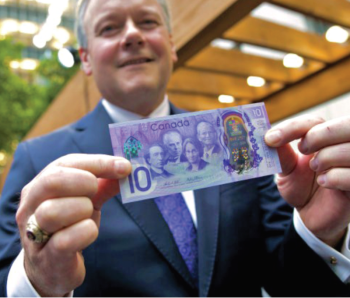
Canada’s Underwhelming Sesquicentennial
By Tim Lambrinos
Back in 1967, Canada was in the middle of running a massive party to recognize the 100th anniversary of the birth of a nation. Celebrations of all kinds were planned right across the country commemorating Confederation. The federal government established administrations to promote Canada’s achievements, both cultural and historical. The Centennial Commission would fund and direct thousands of special events and activities. Ventures like Caravan, the Centennial Train, the Centennial Medal, a Centennial dollar bill for circulation and numerous music and sports events were conducted nationwide. Local communities organized street parties wearing period costumes to mark the occasion.
A main focus of the year was the immensely successful World’s Fair held in Montréal. Expo 67 would be visited by more than 50 million people. In addition, provinces, municipalities, businesses and individuals held thousands of events that contributed to a national mood of intense pride, excitement and optimism.
The year 1967 also saw the federal government finance new and exciting construction projects in hopes of leaving tangible memories behind. The federal Centennial Commission set aside $25 million, roughly $1 for every person in Canada. Each dollar spent on a centennial event by a municipality was matched by $1 from the federal government and $1 from the respective provincial government. The opening festivities were launched at midnight on Dec. 31,1966, when Prime Minister Lester B. Pearson, Secretary of State Judy LaMarsh (the Minister responsible for the Centennial Commission), Opposition Leader John Diefenbaker and thousands of others participated in a ceremony on Parliament Hill. The ceremony concluded with the lighting of a gas-powered Centennial Flame, while various cities across the nation held their own firework displays, parades, bell-ringing and lighting ceremonies. In Toronto, a torchlight parade and finishing fireworks were held at Queen’s Park, drawing a crowd of 40,000.

Centennial publications and events were all branded with the superb looking Centennial logo, designed by Stuart Ash. The logo was a stylized maple leaf composed of 11 equilateral triangles. Each triangle represented one of Canada’s 10 provinces and the Northwest Territories (Canada’s accepted geography at the time). The Minister of Finance held a competition to design a motif for every Canadian coin. The winning entrant for all denominations was done by artist Alexander Colville. The penny featured a dove in flight; the five-cent piece a rabbit; the 10-cent piece a mackerel; the 25-cent piece a bobcat; the 50-cent piece a howling wolf; and the silver dollar a Canada goose in flight.
In 1967, there was even a spirited patriotic theme song made. “Canada” was created by Bobby Gimby and gained widespread popularity. Another famous song, “A Place to Stand”, was commissioned by the Ontario government for the Ontario Pavilion at Expo 67 and was just as well received. Other sizeable and significant multicultural events were founded, including the inaugural Caribana, held in Toronto. It was established by the Caribbean community to mark the contributions of Canadians of West Indian ancestry. It was during these formative years that Canada passed medicare, enhanced the Canada Pension Plan and said goodbye to the British red insignia in favour of a red maple leaf in our new Canadian flag. Canadians could feel a fresh vibe in the air and our future seemed bright. It was an era ripe for reinvention and idealism. And it felt good. Certainly, an exciting time in our history.
This year, 2017, marks the sesquicentennial of Canada: The 150th anniversary of Confederation. Festivities that were organized by the government fell well short of the buzz that was created fifty years ago. Much criticism has arisen that this year’s organizing seemed too bureaucratic. Even with the making of a new 150 logo and spectacular looking $10 bill. The modified 150 logo now has 13 corresponding triangular elements all within an ornate Maple Leaf. Was it merely too difficult for any celebration this year to realistically compete with the memory of 1967? The year-long remarkable series of events that established a foundation of national pride for Canadians eager to distinguish themselves from their colonial roots.

The government maintains that any discontent in 2017 wasn’t from a lack of trying. Heritage Canada did set the bar of success quite high. One of their 2017 press releases promised, “In honour of Canada 150, this year’s edition will be the most spectacular in Canadian history.”
Parks Canada did their part and offered free admission to national parks and historic sites, a program that crashed its website when it was launched in December 2016.
U2’s Bono and the Edge were recruited to help generate a buzz on Parliament Hill’s July 1 festivities. Rock ‘n’ Roll superstars were also booked to perform a distinctive song at precisely noon. Feature performers included Gordon Lightfoot, Dean Brody and Alessia Cara. Incredibly, the federal government ended up spending $500 million across the country to fund various parties.
Unfortunately, some say Canada 150 events landed with a bit of a thud. Theories abound as to why $500 million didn’t create the desired excitement. Many have expressed that the celebrations ignored atrocities against Indigenous Peoples; that these things should be hand-in-hand with the country’s formation; that there’s little resonance for many Quebecers, especially amid 375th birthday plans in Montréal; that public funds should have been spent elsewhere. Is there an absence of shared unity?
It didn’t help much that this year’s party came just two years after Canada’s Truth and Reconciliation Commission released a damning report detailing the horrific sexual abuse, physical abuse and neglect that indigenous children suffered in residential schools. There’s a lot more awareness these days with prerogatives that Canada is not a perfect country with a perfect history. It may just be a sign of the skeptical times that we live in or that we’ve entered into an age filled with anxiety and distrust of authority and institutions.
In current times, it may seem that many young people have a hard time viewing their own futures with imposing optimism. In Canada today, too many millennials are struggling with things like a tough job market and soaring housing costs. The path to building wealth is proving to be a much steeper hill to climb than the one travelled by their grandparents in 1967.

Another pervading sentiment these days is that there are reprehensible incidents from the past that have tainted our sense of national pride. One notion suggests it was a result of various immoral and dishonourable incidents by our founding fathers. Judgements of past societies should be made by the standards they lived in. It’s necessary to look at what was being said in previous time periods and balance it to what was actually going on in society at the time. How will our society be judged 200 years from now? By today’s standards, past societies always appear to be flawed or even “mean.”
People these days do seem a lot less keen to wave the flag for national interest, especially in Canada. However, a strong belief exists that we should continue to set our own standard and support for proud national patriotism in Emery.
Our numerous Canadian flags throughout Emery stand and wave proudly, showing respectable self-esteem in national branding. Patriotism shouldn’t be so elusive. Merely looking at our troubled neighbours to the south should stir some of our own pride in our nation. Canada, despite its challenges, is a wonderful and progressive place.
The Emery Village BIA is proud to maintain a high standard of support toward ultimate patriotism, independence, self-government, nationalism and national pride. More than ever, diversity needs to truly be our strength. There remains hope that Canada’s bicentennial may prove to be much more commendable and fantastic for us. Yeah for Canada in 2067.














